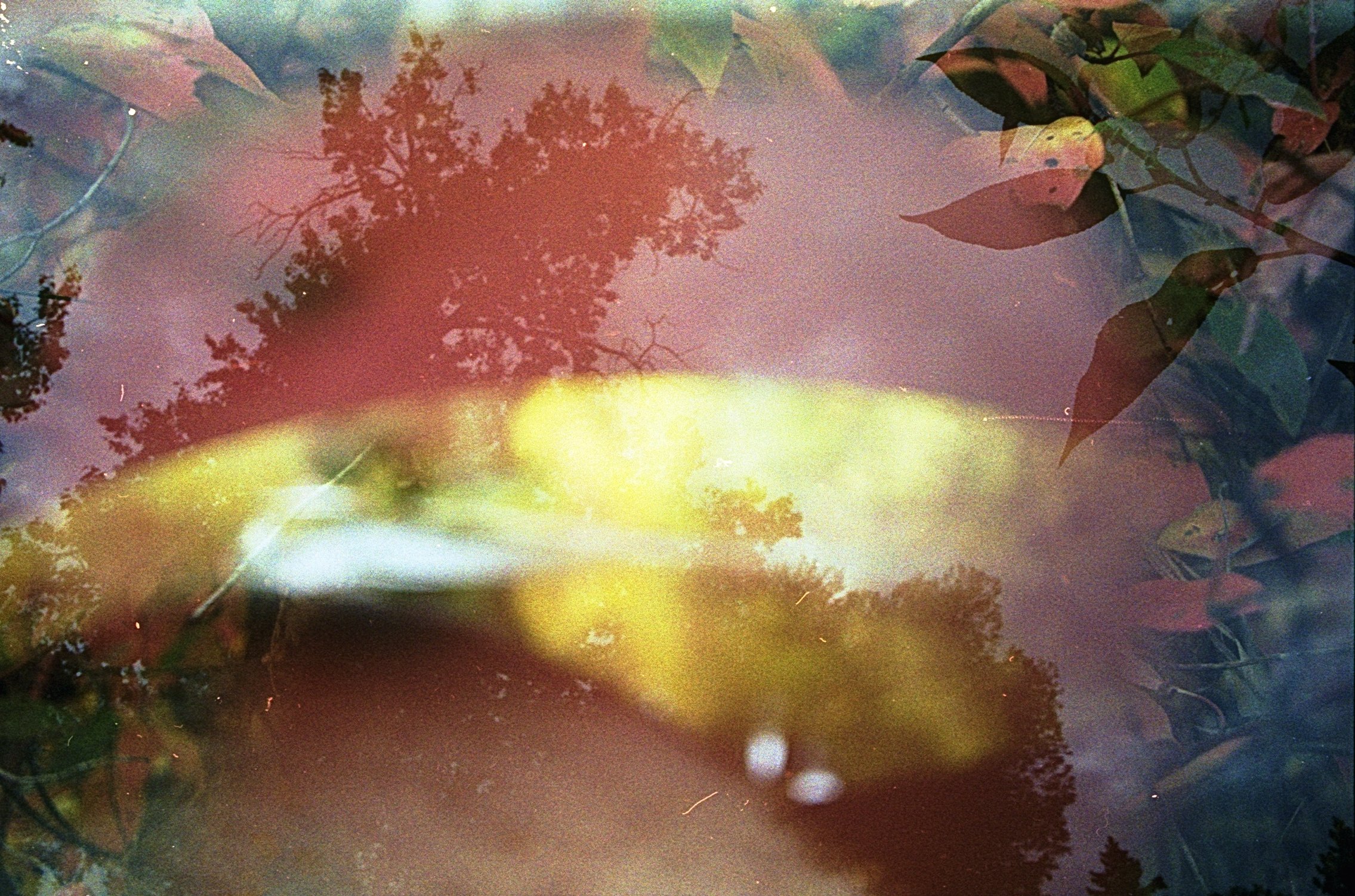Sitting In (For The Scene)
Slavek Pytraczyk
Sitting In (for the scene), 35mm Multiple Exposure Photograph
“It’s maybe one out of 36. That’s not bad, I guess!”
Interview by C. VanWinkle
October 10, 2023
What was the prompt that you responded to? Can you describe it for me?
It was a combination of an image of a mostly nude male and what looked like a line of a poem. So it was kind of a collage piece. The text said, “I bite, I never chew. I do not digest the soft and sour nature of you.” The prompt was kind of a visual poem, so to speak.
And what did it say to you?
It sounded like it was commenting on overcoming or getting through some sort of negative relationship, something along those lines. And then the image… I don’t even know what else to say other than that it was a male.
You told me initially that this prompt was a ‘toughie.’
It was a little bit hard to respond to, which you probably get all of the time. Or maybe not.
It’s a pretty common reaction. People often need some time before they know how to get in and do something with it.
Yeah, I didn't know where to go with this one, but I finally went in some direction. You reminded me that the finished product could be closely related to the prompt, or not so closely related.
How did you finally get started on your piece?
My main concept was to work off of the poem, assuming that writing was a piece of poetry. It just so happened I’d started reading a book entitled “The Poetics of Space” by Gaston Bachelard. I recently met a guy who’s way more into photography than I am, and he recommended this book. So I tried to create a poetic image that speaks to the poetry I read in the prompt.
Oh that’s cool. I don’t know this book. What is a poetic image?
I don't even know! [both laugh] I just started reading this. I’m still in the introduction. But I really like this particular line that says, “Setting is more than scene in a work of art.” The way I interpreted that line was to try to capture something that's maybe less representational, that stands in for the reality or the whole of the scene that you may be in. So maybe that's what a poetic image is? [laughs] Something like that.
That's wonderful. How many layers am I looking at in your finished image?
I’d have to double-check, but it’s four or five images altogether.
So it’s like a quadruple exposure. At least! What made you want to go so panoramic?
It just ended up being that way. It's on a roll of 35mm film that I shot and it's the longest continuation of an image on that entire roll. A lot of the other images on that roll are between two and three images long. I'm still trying to work out how I can do even more per roll that are that long, like four, five, or six images. So it's not something I consciously decided on. It's very unpredictable and I just shot it without thinking too much about it.
I think that's doing it right.
I remember being stuck on a piece a long time ago when I was taking art at Alberta University of the Arts. My instructor said, “You know what, just do it. Don't think about it too much, don't overthink it, just lay something on your canvas,”. That was fifteen years ago and that philosophy still sticks with me today. If you're stuck, just start doing something and eventually something will emerge.
How does this piece relate to the rest of your work?
It relates because it's still very photographic. I've been working on using film photography primarily as one of the mediums that I work in. It's just a different direction in terms of content that I've created, compared to the past. I've already started to work on a second roll of color film, I think quite similar to what I just shot, because I’ve had a lot of positive responses to this piece. It could be a new side project or something along those lines. Who knows what it’ll be, but it definitely could be something that I continue doing. I basically tried to capture a scene of Autumn, but not in a super representational way.
It's so warm! So much of your work that I’ve seen is more stark or cold, ruins, dilapidated buildings in black and white, stuff like that. So I was surprised when I saw this piece with its warm colors and plants. It looks like it's alive. It sounds like this is a new direction for you.
At least for the next roll or two that I shoot, I would say so. Definitely. The process is so strange when doing multiple exposures because you’re sacrificing the whole roll of film for one idea. That's how I view it anyway. The whole thing is quite unpredictable. You don't know what results you're going to get because you can't preview the images after you've taken them. So you’re just hoping for the best, that you get one or two images per roll that you can somehow use for your project or series or whatever you’re working on. It's maybe one out of 36. That’s not bad, I guess! As long as it’s not zero.
If it's zero, that's an expensive failure.
A little bit, yes. It's more of a time-consuming thing because it takes a little while to get through a roll of film, especially if you're shooting multiple exposures. There are typically 36 images on a roll, so if you're doing, let's say, 36 double-exposures, that's 72 pictures you have to take. And if they’re triple-exposures, it’s over 100 already. So it takes hours if not days to get through a roll.
Wow, that adds up fast. How did this experience with Bait/Switch compare to the other time you did it?
It was quite a bit different. I felt more comfortable going into the second project, but I found the image to respond to more difficult. I've gotten to know you and Lu a bit and I have a better sense of who you are. You know, I'm not coming in from the cold, so to speak. You're a very personable guy, which made it easier. But the prompt was just a little bit more challenging than the first.
I often hear from people that the second time is less stressful because they're already familiar with the process and with us. So that's pretty common. When I interviewed you the last time, you said that taking a photo of your hand was unusual because you rarely put people in your images. Has that changed? Has your work evolved since the last time we met?
It wasn't a direction that I ended up taking, human subjects in my work. It's still on the back burner. I know that someday I'm going to want to include either portraiture or some sort of human figure. I just find it still so daunting. I'm more comfortable with shooting something that exists on the street or in the wild, like a public space or a landscape. Those are more approachable than a human. One day I will do it and I'll let you know, [laughs] whatever year that may be.
I look forward to it! Hey, you could practice by taking more pictures of yourself.
Absolutely. That’s a pretty good idea.
So now that you have participated in this project twice, what is your advice to a new person getting their prompt today?
I would say let the idea simmer for a few days unless something pops up into your head immediately. Let it simmer. Think about it for however long you need to, a few days or whatever, and then I think something will start emerging. If it doesn't, I'll fall back on my former instructor’s words: Just start doing something. Stop thinking about it so much and start working on anything, and something will start to emerge and evolve from your first mark.
I think I had the same instructor!
Call Number: C107VA | C109VA.pySi
Slavek Pytraczyk: I am a Polish-born visual artist interested in blurring the lines between the practices of photography, painting, and public art, while simultaneously focusing on public spaces that are often overlooked. Creating these hybrid pieces, I attempt to add to the history of these mediums within my body of work.





